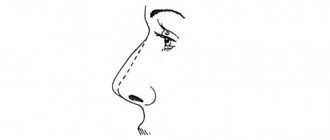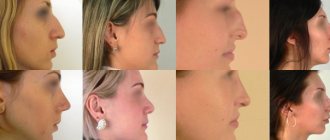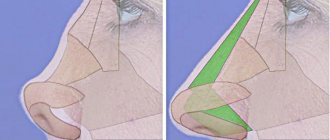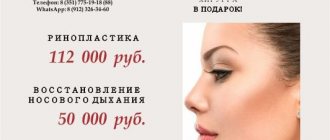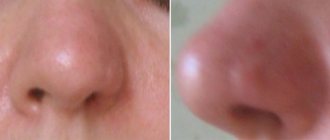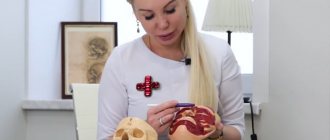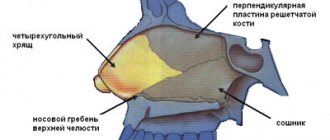Surgery to correct the nasal septum (septoplasty) is a subtype of rhinoplasty that is designed to correct a deformed nasal septum. It can become deformed (curved) as a result of a previous injury, an unsuccessful operation, as a consequence of an illness, or it can be this way since the patient’s birth.
A deviated nasal septum is not only a cosmetic defect, but also an obstacle to free nasal breathing, as well as the cause of chronic inflammatory processes. But septoplasty can correct this problem once and for all.
There are these types of operations:
- Endoscopic septoplasty. In this operation, bone, cartilage tissue and mucous membrane are excised directly inside the patient’s nasal cavity, without the use of additional incisions. The undoubted advantage of such an operation is the absence of a long recovery period. All manipulations are carried out using an endoscope, which gives this type of nasal septum surgery its name. The operation is quick and usually lasts no more than an hour. The rehabilitation period is usually short.
- Laser correction. This type of septoplasty is considered the most painless and safe. The rehabilitation period after the laser method is very short, and the risk of hematomas, perforations and suppurations is minimized. The procedure takes about 30 minutes. A significant disadvantage of this type of septoplasty is that the laser beam cannot correct serious problems and deformations.
Protocol for non-surgical rhinoplasty using Bio S Line mesothreads.
Introduction
Thread rhinoplasty can correct many aesthetic defects.
Compared to surgical manipulations, its advantages are that it is low-traumatic, does not require long rehabilitation and does not lead to the psychological discomfort experienced by patients who are forced to walk with a bandage on their face. Also, the thread lifting procedure has few contraindications and, if performed by an experienced cosmetologist, gives a minimal percentage of side effects.
Non-surgical nose correction using threads helps to narrow a wide base, form a clearer contour, correct the shape of the wings of the nose, and correct a long or drooping tip.
Clinical case
Patient, 35 years old. Complaints about an inharmoniously large nose relative to the geometry of the face. Bio S Line mesothreads made of polydioxanone (first porosity class) were chosen for correction:
- threads with bidirectional notches arranged in a spiral, “Christmas tree” in an atraumatic cannula Cog 2 (75 mm) - 2 pcs.,
- Dual Arm Needle threads (29 cm), C-shaped, with bidirectional notches, located on two atraumatic needles - 1 pc.
Procedure protocol
The procedure was carried out in two stages.
First stage. Formation of the upper line of the nose. Installation of herringbone threads in the Cog 2 cannula.
- We carry out primary processing and marking.
- We anesthetize only the tip of the nose. Here we use a trocar to create a shallow puncture for installing threads.
- We insert two cannulas one at a time and pass them along the back of the nose, controlling the installation layer (strictly subdermal).
- We flood the anchor part of the threads, and then remove the cannula. Pull the thread by the free end. We cut off the ends of the threads and embed them in the fabric.
Second phase. Formation of a clear contour of the nose, correction of the tip. Installation of Dual Arm Needle threads.
- We anesthetize only the injection and puncture points (the lateral surface of the tip of the nose). When choosing an injection point, it is important to remember about anatomically dangerous zones.
- Install the threads from top to bottom. Alternately, from one channel, we pass atraumatic needles along the lateral surfaces of the nose, thus visually emphasizing a clear contour.
We place the needles strictly in the subdermal layer, controlling the layer with pendulum-like movements.
- We make punctures along the side surface of the tip of the nose, pull out the thread completely, sinking the knot into the dermis.
- We tighten the threads by placing soft tissue on the thread. This way we form clearer lines of the nose. There is a visual shortening of the nose, the boundaries of the nose are drawn.
- Cut off the loose ends and embed them in the fabric.
Correction result
As a result of the procedure, it was possible to form clearer side edges, raise the tip, make the nose more neat, and the face more harmonious.
Conclusion
Adramatic Bio S Line needles and cannulas, the absence of excessive separation by the trocar, as well as minimal anesthesia reduce the risk of edema and hematomas as a result of the procedure. There are practically no traces of implantation. The effect lasts up to one and a half years.
The procedure for nose correction using Bio S Line mesothreads allows you to achieve a noticeable aesthetic correction of the nose without affecting the patient’s social lifestyle.
Author: Milena Papikyan, dermatovenerologist, cosmetologist, Moscow.
Magazine: Appearance. Esthetic guide №5(33)
How is the operation performed?
Septoplasty is considered a rather complex operation, since not only the outer integument is subject to correction, but also bone and cartilage tissue. Septoplasty is usually performed under general anesthesia to minimize the patient's discomfort.
Before carrying out it is necessary to undergo tests for the general condition of the body. Preparation for septoplasty includes the following nuances:
- if correction of a deviated septum is carried out in a woman, then you need to wait 1 week after the end of her last menstruation;
- You should temporarily stop taking medications that affect blood clotting, smoking and drinking alcohol for at least 2 weeks.
The duration of septoplasty can range from 1 to 3 hours. This depends on the complexity of the problem, as well as the presence of individual factors complicating the course of septoplasty. After correcting the deviated nasal septum, special tampons are fixed into the nasal cavity on both sides to stop bleeding. After 24 hours, the tampons are removed and the patient goes home with recommendations. During the week, the patient undergoes a nasal toilet 3-4 times in order to avoid postoperative complications.
There are contraindications, you should consult your doctor.
Rhinoplasty
Precisely because plastic surgery in the nose area is always associated with maintaining physiological functions, its implementation requires high professionalism of the entire operating team - from the rhinosurgeon and anesthesiologist-resuscitator to operating rooms and ward nurses.
Indications for rhinoplasty
Indications for rhinoplasty can be divided into aesthetic and functional. However, in practice, the patient often experiences both. Thus, a curved internal septum makes the nose asymmetrical (aesthetics) and at the same time makes breathing difficult (function).
So, here they are, the indications for surgery:
- Deformations of individual parts of the nose (congenital anomalies and post-traumatic asymmetry).
- Violation of the physiological functions of the nose of a post-traumatic nature.
- Asymmetry caused by uneven growth of the facial bones.
- Individual patient dissatisfaction with the shape, length or width of the nose, the shape of the nostrils, the tip or back of the nose.
At what age can you have rhinoplasty?
To achieve an optimal aesthetic result, it is important to contact a plastic surgeon who specializes in rhinoplasty in a timely manner.
In cases where the facial bones have not yet fully formed, surgery for aesthetic reasons (shape, size of the nose, presence of a large hump) is postponed until the bones stop growing and moving.
However, in order to decide when it is possible to change the shape of the nose, it is still necessary to come for a consultation with a specialist - a rhinoplasty plastic surgeon, so that he can observe the patient over time and decide not only on the timing, but also on the method of future surgical intervention.
Rhinoplasty after injury
In cases where the shape of the nose and respiratory functions are impaired as a result of injury, on the contrary, the sooner a plastic surgeon intervenes, the better the result will be.
You should not wait for the injured bones and cartilage to grow together and form a new nose, which will disrupt the harmony of the face. Post-traumatic disorders must be eliminated immediately, and this must be done by contacting a specialized clinic, where surgeons with extensive experience in maxillofacial operations work.
Preparation and planning of the operation
Naturally, result-oriented patients are concerned with the question: what will the nose look like after surgery? In order for the effect to be predictable and the face to acquire harmony, the plastic surgery clinic always uses computer modeling during preoperative consultations, which makes it possible to show with great accuracy the planned results of the future intervention.
Also during the consultation, a study of the main function of the nose - breathing - is carried out using rhinomanometry. For a modern rhinoplasty center, this is a mandatory research method.
The operation is also preceded by a complex of medical examinations and a consultation of specialists who resolve the following practical issues:
- type of anesthesia. Many patients believe that general anesthesia is much more dangerous than local anesthesia and choose those clinics where they are promised that they will not be put into drug-induced sleep. However, for a person who sees and hears everything that happens not only, as they say, in front of his nose, but literally inside his nose, this is a lot of stress, even if pain is not felt.
Much more comfortable, and, most importantly, safer - medicated sleep, which is controlled by an experienced anesthesiologist-resuscitator, and modern equipment monitors the patient’s condition, and employees in a close-knit operating team understand each other without further ado;
- type of rhinoplasty. There are many myths that closed rhinoplasty is better than open rhinoplasty. They are associated with the fear that scars will remain on the nose after open rhinoplasty.
With closed rhinoplasty, the surgeon works by gaining access through the natural nasal cavities, while with open rhinoplasty, he lifts a skin flap and thereby gets the opportunity to more carefully and meticulously excise, connect or implant tissue. A thin strip of suture at the base of the central dividing column of the nose - the columella - soon after the operation becomes completely invisible.
— degree of impact. Many patients have little idea of the extent of changes that allow them to achieve harmony in their facial features. Meanwhile, here the calculation is literally in millimeters, and the rhinoplasty operation in quantitative terms is close to microsurgical, which increases the responsibility of the rhinoplasty plastic surgeon. A precise hand, mathematical calculation and the ability to foresee the future shape of the nose in conjunction with the entire face are very important here.
Theorinoplasty
Rhinoplasty has always been considered one of the most popular operations in plastic surgery. Traumatic surgery can cause complications and require long-term rehabilitation. In our clinic you can use the services of changing the size and shape of the nose using a new innovative method - theorinoplasty. Minimally invasive surgery reduces risks to a minimum percentage, and recovery will require a record short time.
Benefits of theorinoplasty
Theorinoplasty is named after its creator Teoman Dogan, a candidate of medical sciences, plastic surgeon and anatomist. The method allows you to minimize trauma and securely fix the tip of the nose. As a result of the operation, such a complication as a drooping nasal tip was excluded.
The advantages of theorinoplasty include:
- The surgery is performed through small incisions inside the nose.
- Theorinoplasty is performed without removing the costal cartilage.
- After the procedure, long hospitalization is not required.
- The use of modern splints and minimally invasive surgery allows a person to breathe freely immediately upon awakening after surgery.
- 100% protection against nasal tip drooping, unlike other methods.
How is the rehabilitation going?
Theorinoplasty of the nose allows patients to go home from the clinic the next day. You can begin work duties in 3–5 days, and after a week you can fly on an airplane. You are allowed to return to your normal daily routine after a month. You will be able to engage in active sports, visit swimming pools, baths, saunas, etc.
The final result of theorinoplasty will be visible after 2 months. During this period, tissue stabilization will completely occur. The main advantage is the absence of a “snub nose” - an upturned tip. The method is also suitable for patients who have previously undergone rhinoplasty. This minimally invasive surgery can be performed on people of any age. Restrictions are only due to health reasons.
Features of theorinoplasty
The original shape and size of the nose does not matter - theorinoplasty helps in any case. Our patients can be confident in a stable result. The success of the operation is ensured by the use of theostratum: the cartilaginous formations of the nasal septum are carved out in the form of a small strip, which is attached to the end part of the septum. Not theostrate, all soft tissues are located together with cartilage, ligaments and epidermis. Despite the pressure of gravity, the theostrat excludes the possibility of the tip falling completely. As a result, our patients receive an aesthetic appearance without negative consequences.
Theorinoplasty is indicated not only for beauty - it is a rational solution to the problem of constant nasal congestion. Correcting the septum and shape at the same time will help you get rid of unpleasant symptoms and give your appearance a harmonious aesthetic.
